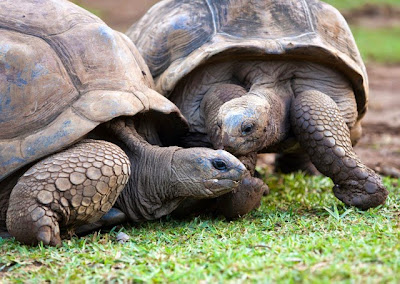The Galapagos Islands are located in the Pacific Ocean, about a thousand kilometers to the west of Ecuador in South America. The name of the Islands Galapagos comes from the shape of the giant tortoises shell that looks like a saddle.
 It is the main endemic species that lives in this paradise.
It is the main endemic species that lives in this paradise.They are the largest turtles in the world (over 400 Kilos ) and the oldest known to live more than 150 years or age.
Fully grown adults can weigh more than 300 kilograms (661 pounds) and measure 1.2 meters (4 feet) long. The Galapagos tortoise grows continuously for about 30-40 years to reach a size of about 1.50 meters .
Scientists believe the first tortoises arrived to Galapagos 2–3 million years ago by drifting 600 miles from the South American coast possibly vegetation rafts or on their own. They first Colonied the eastern-most islands of Española and San Cristóbal, then they dispersed throughout the archipelago, eventually establishing at least 14 separate populations on ten of the largest Galapagos Islands.[1]
There are more than 15 subspecies of Galapagos tortoises in the Islands,
but as of this date, only 11 of these have survived and they all are in danger
of extinction. Lonesome
George died in June of 2012 .It was the last of its species. One of the main causes of death of thousands of Giant
tortoise was by pirates, hunters and whalers who appreciated their fresh meat. Tortoises were also
exploited for their oil, which was used to light the lamps of Quito. One of the
giant tortoise’s most amazing adaptations — its ability to survive without food
or water for up to a year — was also the indirect cause of its demise.. Two
centuries of exploitation resulted in the loss of between 100,000 to 200,000
tortoises. It is estimated that 20,000–25,000 wild tortoises live on the
islands today.[2]
So, there are also animal threats to
turtles as pigs, dogs, cats, rats, goats and cows which alter their means of
food and feed on their eggs.
There are three variations of Giant tortoises in the Galapagos Islands and are classified according to
their hábitat:
their hábitat:
Carapace as Domo , which characterize the Tortugas Islands living in high humidity and abundant
vegetation , such as in the Isla Santa Cruz and in some volcanoes of Isabela Island.
In the
form of saddle, with an elevation in the front (to facilitate the extension
of the neck) is characteristic of the turtles that live in arid and less
vegetación. An example of these turtles are those living in the Española Island
, Fernandina , Pinta and Pinzon, where there are cactus trees and shrubs.vegetation , such as in the Isla Santa Cruz and in some volcanoes of Isabela Island.
And finally there is an intermediate race is on Santa Fe, which combines the features of the previous two.
These features mentioned were the fundament of Charles Darwin to demonstrate the evolution of
species according to their habitat.
species according to their habitat.
[1]GALAPAGOS CONSERVANCY, http://www.galapagos.org/about_galapagos/tortoises/
[2]GALAPAGOS CONSERVANCY http://www.galapagos.org/about_galapagos/tortoises/

No comments:
Post a Comment